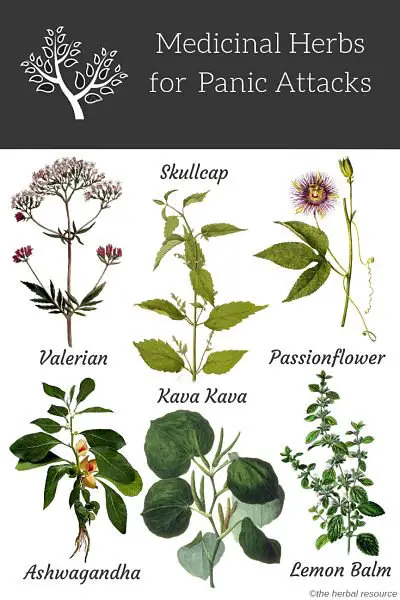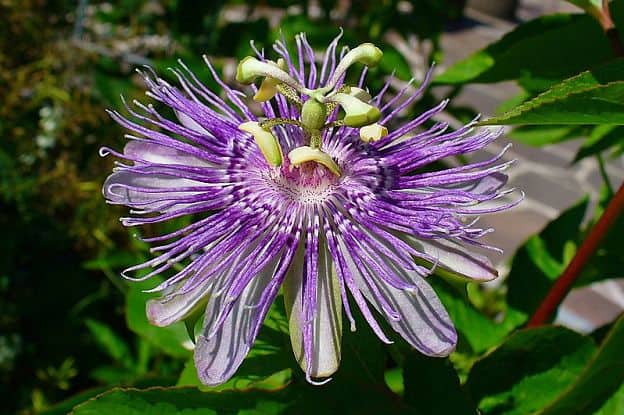Medicinal herbs for panic disorder or attacks and anxiety are usually not sufficient treatment on their own.
Those suffering from panic or general anxiety should also consider seeking medical and psychological counseling to get at the root problems.
In some cases, the causes of panic attacks are withdrawal from drugs, most notably antidepressants, or by physical problems such as hypoglycemia, hyperthyroidism or some forms of heart disease.
Panic attacks are episodes of extreme anxiety, experienced as greatly increased heart rate (palpitations), hyperventilation and sometimes chest pain, nausea, vertigo, and sweating. For some sufferers, the attacks may occur during periods of stress, while others may suffer from these attacks for no apparent reason.
Panic attacks are diagnosed as symptoms of either panic disorder or the less severe generalized anxiety disorder; therefore, treatments for panic are often the same as those given for general anxiety.
As panic attacks are often sudden and brief, medicines are not always an effective relief. Those who are prone to panic attacks can learn specific mental exercises to help calm themselves and thus shorten or even head off the attacks.
Where herbal medicines can be useful is in lessening the severity of the person’s underlying anxiety and nervousness, thus lessening the frequency and severity of the panic attacks.
These medicinal herbs are either sedatives or tranquilizers (also known as anxiolytic agents) and are either used on a regular basis to reduce the overall feeling of anxiety or sometimes during the actual panic attack if it is prolonged.
Traditionally there has not been much distinction made between tranquilizers and sedatives. However, pharmacologists have in recent years begun to identify the specific chemical action of these drugs and thus separate out the anxiolytic action from the sedative action.
The hope is that an anxiolytic agent (tranquilizer) can be found that does not have the negative effects of pharmaceutical sedatives— especially the benzodiazepines, which can be habit-forming and cause memory loss.
The ideal treatment for anxiety would be a chemical or group of chemicals that relieve anxiety and panic without resulting in the drowsiness and other problems of many prescribed sedatives.
If a person has been diagnosed with some underlying medical condition, e.g. hypoglycemia, hyperthyroidism, Wilson’s disease, that may be causing the panic attacks then herbal remedies can be considered for those specific conditions. (1)

6 Promising Herbs for Panic Attacks and Panic Disorders
1. Valerian
Valerian (Valeriana officinalis) is one of the most commonly cited medicinal herbs for panic attacks and general anxiety.
It has been in use as a sedative since ancient times and still commonly used in Europe. It is a small, herbaceous plant with fernlike leaves and white or pink flowers. It is the root of the plant that is used for medicine.
Valerian’s mode of action in quelling anxiety is thought to be GABA(A)-ergic, meaning that it interferes with the body’s natural excitatory chemical signals in much the same way that the commercial benzodiazepine drugs do. (2)
The well-known British herbalist Andrew Chevalier recommends that a mild decoction (tea) be made from the dried root and rhizome of valerian and one cup taken at night.
Tablets and capsules are also commercially available but these are usually a mixture of several herbs and should be checked against any personal sensitivities.
There are some reported side effects with valerian and some drug interactions.
It is recommended that those who have liver disease should not take valerian and it should be avoided by women who are pregnant or nursing.
2. Skullcap
Skullcap (Scutellaria lateriflora) is another well-known and frequently cited medicinal herb for anxiety and may be helpful to persons suffering from panic attacks. (3)
The flowers of species of skullcap are similar in shape to those of snapdragon (Antirrhinum majus), native to North America and known there as Virginia skullcap or mad dog—that has traditionally been used as a sedative.
One should be aware that there are hundreds of other species of skullcap and many of these are used for entirely different medicinal purposes.
The anxiety-reducing effect of blue skullcap on humans has been confirmed in clinical trials and at least one chemical mode of action has been found: the flavonoids in blue skullcap interfere with serotonin’s ability to activate the cell surface receptor 5-HT(7), thus reducing the body’s natural excitatory representations. (4)
Many herbalists recommend that blue skullcap is taken as a tincture. It should never be consumed directly. As with other tranquilizers, prolonged use of skullcap can lead to liver damage.

3. Purple Passionflower
Purple passionflower (Passiflora incarnata), is one of the several species of passionflower that are native to the southeastern U.S., where it also goes by the name of “maypop”.
It is a weedy vine that bears beautiful purplish flowers, similar in appearance to many other species in the genus. It has been used by native Americans as a mild sedative and to treat anxiety and restlessness.
Today, it is recommended by herbalists as a safe sedative and the U.S. Food and Drug Administration recognizes it as generally safe. It is usually taken as a tea.
There are a number of flavonoids isolated from passion flower and laboratory studies show that these chemicals are GABA-ergic, meaning that, like valerian, they have a chemical action that mimics the class of pharmaceuticals known as benzodiazepines.
However, because the anxiolytic effect of passion flower appears to be non-habit forming it is considered a good replacement for the standard benzodiazepine tranquilizers and as therapy for those who are withdrawing from narcotics. (5)
These conclusions were made after not only laboratory tests on animals but also double-blind, placebo-controlled clinical trials with humans. (6)
The recommended preparation is either an infusion made from the fresh leaves and stems or a tincture prepared in a ratio of 1:5 (herb: water).
The naturopathic doctor Michael Traub recommends an infusion made with 2 g of dried herb in 150 ml of water, two to three times a day.
It should be noted that some species of Passiflora are poisonous; therefore this remedy should only be obtained from a reputable herbalist.
4. Indian Valerian
Although not as commonly available as Valeriana officinalis, Indian valerian (Valeriana jatamansi) has long been used in traditional Chinese medicine.
When combined with other medicinal herbs for panic attacks it was found to have a calming effect (anxiolytic) without sedation. The experiment was performed on mice. (7)
The implications for humans are untested but it is hoped that further research on this plant will lead to an anti-anxiety drug that does not cause sedation and addiction.
Of course, for those who practice Chinese medicine, the evidence is already there in the long history of valerian being used to calm the nerves.
5. Danshen
There are numerous plants in the genus Salvia (the sages) that have psychoactive chemicals and have been used in traditional medicine.
In fact, there are at least twenty-seven documented psychoactive species of Salvia, according to a list compiled by Australian herbalists.
Some of these species have become the focus of laboratory research, with the goal of finding non-addictive medicines for anxiety and depression.
Two of the more promising medicinal herbs for panic attacks in the genus Salvia are danshen and mirto.
Danshen (Salvia miltiorrhiza), also known as Chinese sage or red sage, is a plant is native to China and Japan and has long been used for treating heart and liver problems.
It is the red root that is used, and the principal active compound is called miltirone.
Researchers have discovered other medicinal properties of danshen, including the anti-anxiety effect of the terpenes found in the plant. (8)
However, because of the anticoagulant action of danshen, it should be avoided by those who are already taking blood-thinning medicines such as warfarin as the result could be uncontrolled bleeding. (9)
Note that the sedative agents are in the roots and leaves of the danshen; whereas the seeds actually contain a stimulant.
6. Mirto
Mirto (Salvia elegans) is another plant in the Salvia genus but native to Mexico and Central America, where it has been used as a folk medicine to calm the nerves.
It is also known as “pineapple sage” in the southern U.S., where it has been cultivated as an ornamental plant. Both the flowers and leaves have a pleasant pineapple scent.
The traditional claims of mirto’s antidepressant and anti-anxiety qualities have been confirmed by laboratory studies. The chemical action is thought to be the inhibition of angiotensin II and acetylcholinesterase. (10)
What this means is that the natural chemicals in the mirto extract are blocking the body’s signals for raising blood pressure while also allowing the natural signal to lower heart rate. (11)
Because these particular plants are less common in the medicinal plant market, the recommended preparations and dosages have not been confirmed.
A reputable herbalist should be consulted before taking any of these medicines.
Other Medicinal Plants That May Be Promising as a Treatment for Anxiety, Panic Attacks and Panic Disorders
- Kava Kava – (Piper methysticum)
- Ashwagandha – (Withania somnifera)
- Lemon Balm – (Melissa officinalis)
- Lavender – (Lavandula angustifolia/Lavandula officinalis)
- Chamomile (German Chamomile) – (Matricaria recutita/Chamomilla recutita)
- Cannabidiol (CBD) oil
Supporting References
- Lakhan, S. E., & Vieira, K. F. (2010). Nutritional and herbal supplements for anxiety and anxiety-related disorders: a systematic review. Nutrition Journal, 9, 42. doi:10.1186/1475-2891-9-42.
- Murphy, K., Z. J. Kubin, J. N. Shepherd, and R. H. Ettinger. Valeriana officinalis root extracts have potent anxiolytic effects in laboratory rats. Phytomedicine. 2010, 17(8-9): 674-678.
- Wolfson, P; Hoffmann, DL (2003). “An investigation into the efficacy of Scutellaria lateriflora in healthy volunteers”. Alternative therapies in health and medicine 9 (2): 74–8. PMID 12652886.
- Gafner, S., C. Bergeron, L. L. Batcha, et al. Inhibition of [3H]-LSD binding to 5-HT7 receptors by flavonoids from Scutellaria lateriflora. J. Nat. Prod. 2003, 66(4): 535-537.
- Kamaldeep, D., S. Kumar, and A. Sharma. Anti-anxiety studies on extracts of Passiflora incarnata Linneaus. J. Ethnopharmacol. 78 (2–3): 165–170.
- Assessment report on Passiflora incarnata L., herba. Committee for Herbal Medicinal Products (HMPC). European Medicines Agency. 25 March 2014 EMA/HMPC/669738/2013.
- You, J.-S., M. Peng, J.-L. Shi, et al. Evaluation of anxiolytic activity of compound Valeriana jatamansi Jones in mice. BMC Complementary and Alternative Medicine 2012, 12: 223.
- DePalma, A., R. Rossi, M. Carai, et al. Pharmaceutical and biomedical analysis of terpene constituents in Salvia miltiorrhiza. Current Pharmaceutical Analysis 2008, 4:249-257.
- Chan, T.Y. 2001. Interaction between warfarin and danshen (Salvia miltiorrhiza). Annals of Pharmacotherapy, 2009, 35(4): 501–504. doi.
- Herrera-Ruiz, M., Y. Garcıa-Beltran, S. Mora et al.Antidepressant and anxiolytic effects of hydroalcoholic extract from Salvia elegans. 2006, J. Ethnopharmacol. 107(1).
- Jiménez-Ferrer, E., H. Badillo, M. González-Cortazar, et al. Antihypertensive activity of Salvia elegans Vahl. (Lamiaceae): ACE inhibition and angiotensin II antagonism. 2010 J. Ethnopharmacol. 130 (2): 340–346.
Supporting References – Offline
Chevalier, Andrew. The Encyclopedia of Medicinal Plants. New York: DK Publishing, 1996.
Graedon, Joe and Teresa. The People’s Pharmacy Guide to Home and Herbal Remedies. New York: St. Martin’s Griffin, 2001.
Ngan, A., and R. Conduit. A double-blind, placebo-controlled investigation of the effects of Passiflora incarnata (passionflower) herbal tea on subjective sleep quality. Phytotherapy Res., 2011 25 (8): 1153–1159.
Traub, Michael. Passionflower (Passiflora): an overview of the research and clinical indications. Gaia Herbs.
Leave a Reply